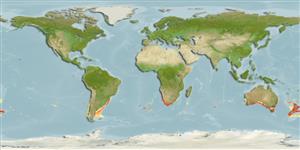Environment: milieu / climate zone / depth range / distribution range
Ecología
marino demersal; rango de profundidad 50 - 854 m (Ref. 52581). Subtropical; 28°S - 50°S, 180°W - 180°E
Circumglobal in southern waters: (Ref. 7300): South Africa, Australia, New Zealand, Kermadec I., Desventuradas Is., Juan Fernandez Is., Chile, north to southern Brazil, Tristan da Cunha.
Length at first maturity / Tamaño / Peso / Age
Maturity: Lm 88.0 range ? - ? cm
Max length : 160 cm TL macho / no sexado; (Ref. 89467); common length : 100.0 cm TL macho / no sexado; (Ref. 9258); peso máximo publicado: 100.0 kg (Ref. 4537); edad máxima reportada: 60 años (Ref. 41439)
Espinas dorsales (total): 9 - 12; Radios blandos dorsales (total): 12; Espinas anales 3; Radios blandos anales: 7 - 9
A deepwater species, occurs in seamounts (Ref. 89357). Adults occur generally over rough ground from the central shelf (about 100 m) to the shelf edge and down to the upper slope. Juveniles are found in surface waters, perhaps school in association with drifting weed. Feed on barracouta and pilchards, in addition to various bottom-dwelling fish. Are primary gonochorists (Ref. 58421). Preyed upon by sperm whales (Ref. 9072). It is taken by droplining down to 400 m, and is sometimes seen in the trawled catch. Utilized fresh and frozen; can be steamed, fried, broiled, boiled, microwaved and baked (Ref. 9988). Severely overfished (Ref. 89357).
Are primary gonochorists (Ref. 58421).
Paxton, J.R., D.F. Hoese, G.R. Allen and J.E. Hanley, 1989. Pisces. Petromyzontidae to Carangidae. Zoological Catalogue of Australia, Vol. 7. Australian Government Publishing Service, Canberra, 665 p. (Ref. 7300)
IUCN Red List Status (Ref. 130435)
Threat to humans
Harmless
Human uses
Pesquerías: comercial; pesca deportiva: si
Herramientas
Special reports
Download XML
Fuentes de Internet
Estimates based on models
Preferred temperature (Ref.
123201): 8.6 - 16, mean 11.7 °C (based on 143 cells).
Phylogenetic diversity index (Ref.
82804): PD
50 = 0.8125 [Uniqueness, from 0.5 = low to 2.0 = high].
Bayesian length-weight: a=0.01072 (0.00765 - 0.01500), b=2.99 (2.89 - 3.09), in cm total length, based on LWR estimates for this species (Ref.
93245).
Nivel trófico (Ref.
69278): 4.5 ±0.77 se; based on food items.
Resiliencia (Ref.
120179): Muy bajo, población duplicada en un tiempo mínimo superior a 14 años (tm=10-13; tmax=60).
Fishing Vulnerability (Ref.
59153): High vulnerability (59 of 100).
Climate Vulnerability (Ref.
125649): High to very high vulnerability (70 of 100).
Nutrients (Ref.
124155): Calcium = 34 [20, 61] mg/100g; Iron = 0.904 [0.538, 1.528] mg/100g; Protein = 21 [20, 22] %; Omega3 = 0.563 [0.318, 1.046] g/100g; Selenium = 55.6 [29.6, 108.8] μg/100g; VitaminA = 9.09 [3.16, 24.94] μg/100g; Zinc = 0.368 [0.267, 0.532] mg/100g (wet weight); based on
nutrient studies.
